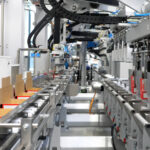Packaging is a highly automated sector, with high-speed processes and solutions that constantly challenge the technological state-of-the-art.
However, for all the advances in automation, there are still a few operations, such as magazine loading, reel loading, semi-finished product loading, and quality inspection that are still undertaken manually, but present issues relating to ergonomics, safety and repeatability.
CAMA focus on Automatic Carton Loading
One such operation that can prove challenging for operators is the loading of carton blank magazines on packaging machines.
Carton blanks are often produced by paper mills hundreds of kilometers away, transported on trucks, unloaded by forklift drivers and stored in the warehouse for weeks or months at a time. These continual logistical operations often result in pallets with misaligned products, excessive folding or carton blanks that exhibit different consistencies and moisture content depending on the season.
And this randomness marries badly with the “rigid” concepts behind automation, as machines so often lack human characteristics such as deterministic vision, discretion in selection and flexibility in picking.

CAMA enhancement in Robotics and Smart Vision
Collaborative robots can replace the arm of an operator, with even greater strength, reach and agility, while grippers equipped with distance, torque sensors and customized gripping systems can mimic an operator’s hand. And these can then be complemented with vision systems, based on 2D/3D or AI-based technologies, to represent an operator’s view.
As a result, with these integrated robotics and vision systems, manual tasks can be automated, not only taking repetitive, time-consuming, burdensome and low value-added tasks away from operators, but also increasing productivity.
Automatic Carton Loading seems to be the solution
Comprising a collaborative robot, equipped with specialized interchangeable product-specific gripping tools, smart cameras and advanced programming, the ACL solution automatically recognizes the pallet pattern, its orientation, the cartons stacks and removable interlayer sheets. It can then grip and load carton blanks into a machine’s magazine automatically. It can also handle closed boxes and can be augmented with multiple smart-tools and functions, including straps removal, case lid tear-off, and automatic size changing. If for some reason a pallet cannot be processed, it can request operator intervention.

The technology integrates seamlessly with CAMA machines, where it can be adapted to fit within available factory real estate. And for modern integrated packaging operations, it can communicate with upstream and downstream machines, so it can prepare to receive pallets transported by AMR (mobile robot).
It can work in harmony, sharing space with an operator in total safety according to all current regulations. It never gets tired, it is maintenance free, thanks to fully electronic technology, it can be monitored remotely, and it feeds essential operational data and statistics into analytics systems.

Future next steps
There are situations with multiple different storage points – but slow cycle times – where a robot for each storage point might be an unjustifiable investment. And other cases where there is reduced installation space, or depalletizing is moved to a warehouse area. In these instances, an ACL system that can move autonomously in the production space could be a solution to these problems.

